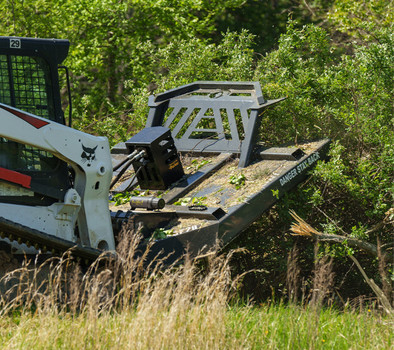Skid Steer Brush Cutters | Know What To Look For
Posted by Mackenzi Griffin on 12th Apr 2024
Skid steer brush cutters, sometimes called brush mowers, are attachments designed for efficient land management jobs. Owning a skid steer brush cutter comes with a lot of benefits, especially for people in landscaping, agriculture, construction, or property management.
These attachments can turn a job that might take days into a couple of hours' work which will free you up for other projects. Although the initial investment might seem high, the overall cost-effectiveness of owning a brush cutter attachment is invaluable.
Let’s talk about some of the practical, economic, and environmental benefits, a brush cutter attachment can provide to professionals and individual property owners alike. Here is an outline of the different styles of brush cutters out there:
Closed Deck Brush Cutters
These are better for flat or even landscapes. They're typically designed with a steel housing or grate that covers the blade, which keeps debris from scattering as you mow and gives a cleaner looking finish to your cut.
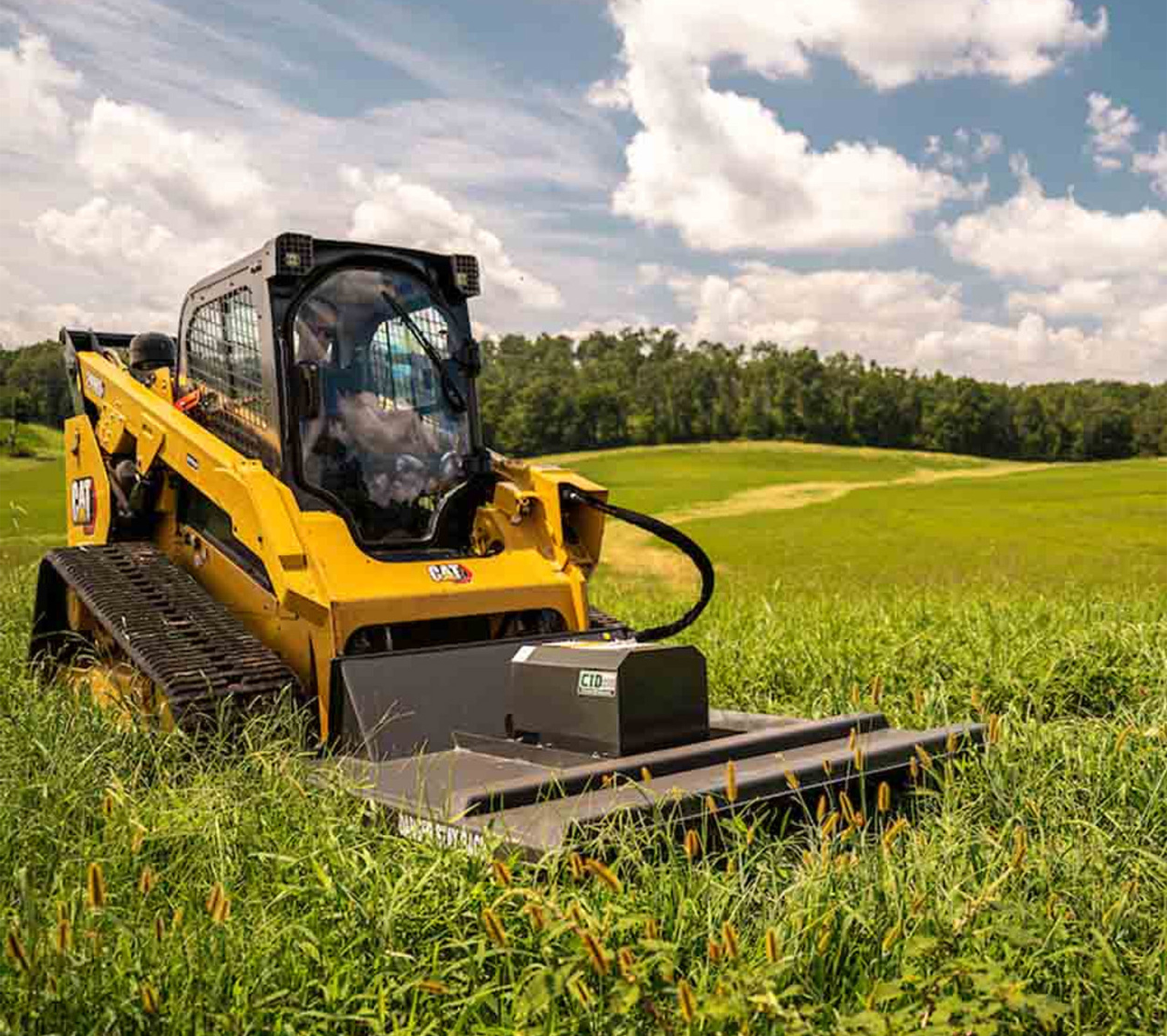
Open Front Deck Brush Cutters
The open-front is good for when you’re cutting heavy undergrowth, thick brush, and saplings. The open-front exposes the blade so that it can aggressively rip through those dense areas of brush by engaging with the material more directly.
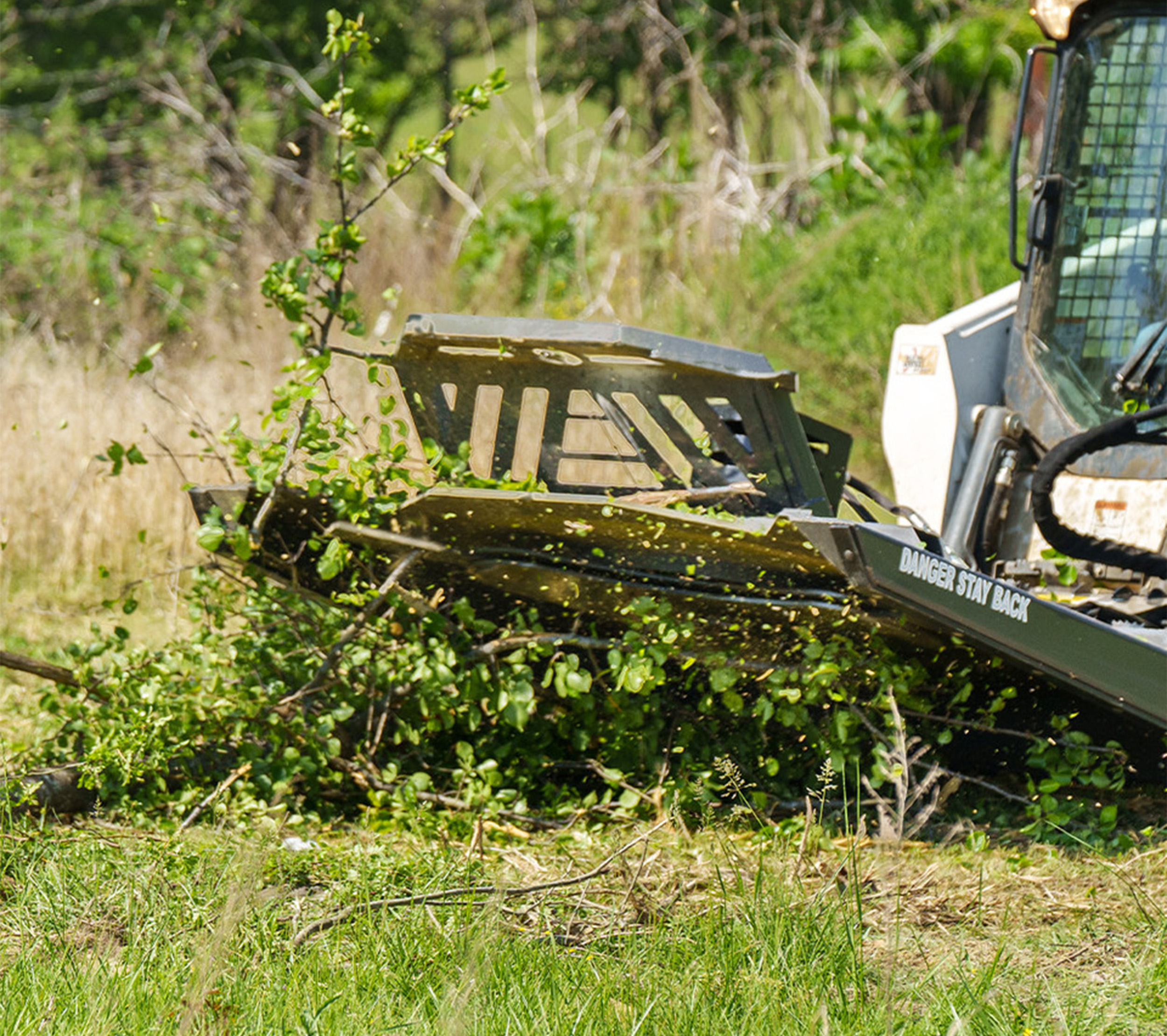
Floating Deck Brush Cutter
Designed for more consistent cutting on uneven terrain, floating decks adjust to the contour of the ground to reduce scalping and gouging. This style is good for operators looking for something they take anywhere and get an efficient cut.
Choosing the Right Deck Type
Consider how important it is to see the cutting area directly (open deck) versus the need to contain debris (closed deck). For rolling terrains, floating decks provide an advantage by adjusting to the ground, for a precise cut. Each deck type serves a purpose based on the job requirements, the density and type of vegetation, and the terrain being worked on. Understanding these key differences ensures that you choose the most effective tool for your brush cutting needs, optimizing both performance and safety.
Blade Design
Brush cutters typically have between two and three bi-directional blades made from high-strength steel which are replaceable for easy maintenance and sharpening.
Drive System
Normally, a hydraulic motor powers the blades and converts the hydraulic flow and pressure from the skid steer into mechanical energy to spin the blades. Some models use a direct drive system for simplicity and efficiency, while others may use a gearbox for more control of the speed and torque of the blades.
Skid Steer Mowers
Each skid steer mower is designed to cut varying severities of vegetation with different blade styles and configurations. There a lot of differences between each style that are important to know before you buy. Here's a look at the most common types of skid steer mowers:
Rotary Cutters
Located underneath the cutting deck are usually high-strength steel blades designed to maintain their sharpness over time. Some rotary cutters use one large blade, while others use a system of multiple small blades that spin at high speeds.
The drive system powers the blades, typically through a hydraulic motor that converts the hydraulic flow and pressure from the skid steer into rotational motion. This system is comprised of a gearbox, drive shaft, and sometimes a chain drive, depending on the model and manufacturer.
Many rotary cutters have skid plates or a rear roller that stabilizes the cutter and controls the cutting height. These components allow the cutter to glide over the ground and protect the deck from wear and scalping the terrain.
Finishing Mowers
The deck is typically made from stamped or fabricated steel with a smooth underside to minimize grass buildup. The design creates a uniform airflow to lift the grass for an even cut and efficient discharge of clippings. Wider decks cover more ground per pass but require more power from the skid steer, which is why finishing mowers come in various widths to suit any job.
Finishing mowers use multiple blades (usually three to five) that are thinner and are designed for high-speed rotation. This blade configuration makes a precise cut and finely mulches the grass clippings. The blades are attached to spindles that are often greasable for easy maintenance, which extends the life of the attachment and keeps it running smoothly.
These mowers are typically powered by a PTO (Power Take-Off) drive system that transfers power from the skid steer's engine to the mower blades. The drive system includes a gearbox and a belt or chain drive that provides consistent blade speed for a uniform cut.
You’ll often find side or rear discharge systems on a finishing mower, that evenly spread grass clippings over the mowed area. Some models come with mulching kits that further chop the clippings into finer pieces, for faster decomposition and returning nutrients to the soil.
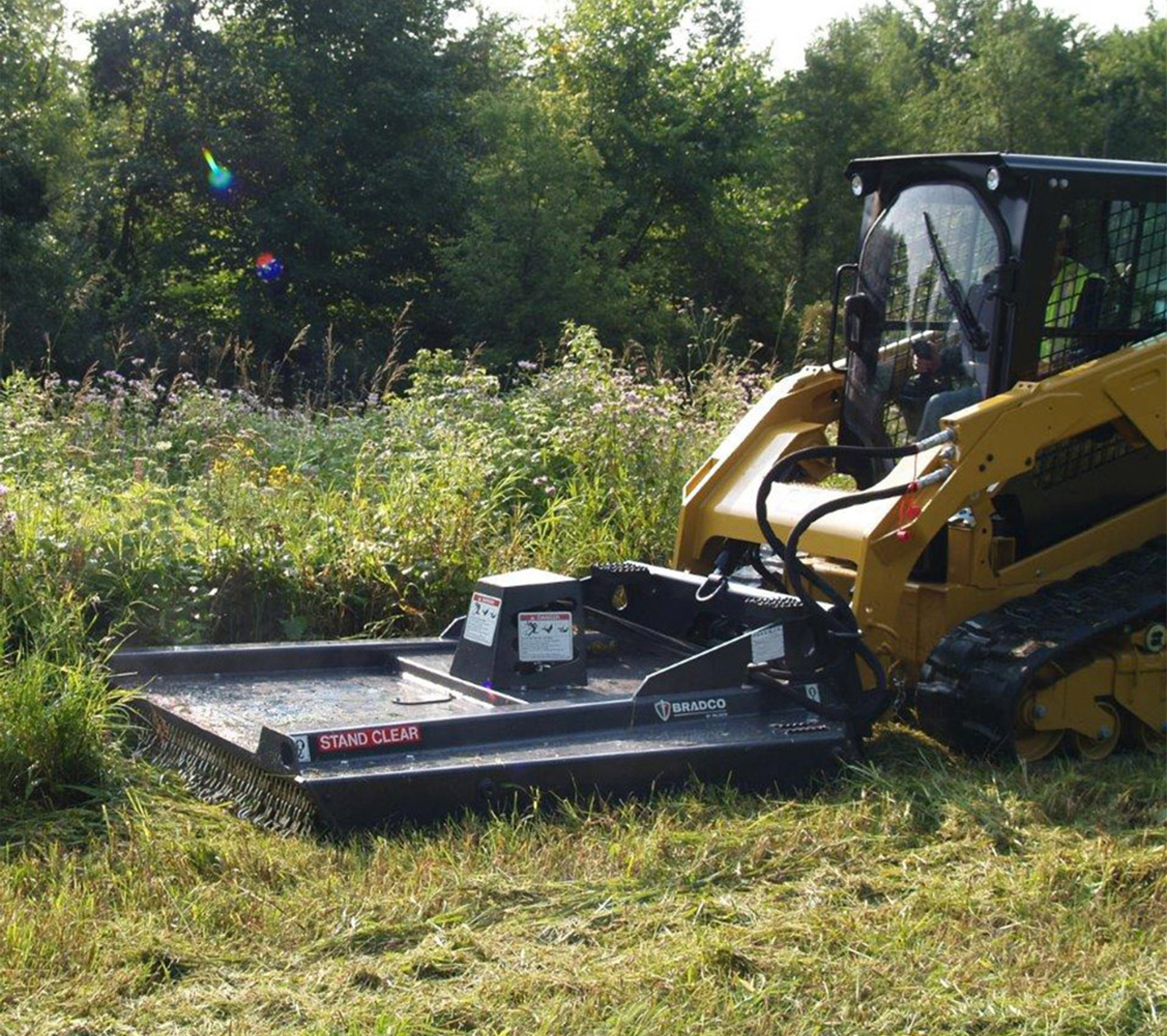
Flail Mowers
A skid steer flail mower is designed for high performance cutting like, thick vegetation, overgrown grass, and messy brush. Flail mowers offer a different approach to cutting, providing a unique advantage in these rough conditions.
Mowing Drum or Rotor
The core of a flail mower is its drum or “rotor,” which spins horizontally. Attached to this drum are numerous “flails” ("y" or "T"-shaped blades) that swing freely. As the drum spins, these flails swing outward by centrifugal force to cut the vegetation.
The flails and body (or housing) are made from high grade steel, making the housing more forgiving upon impact with hidden objects and to withstand the wear and tear caused by cutting through dense vegetation. Their optimal durability makes them a bit pricier but, their strength reduces the risk of damage to the mower, skid steer, and even the operator in some cases.
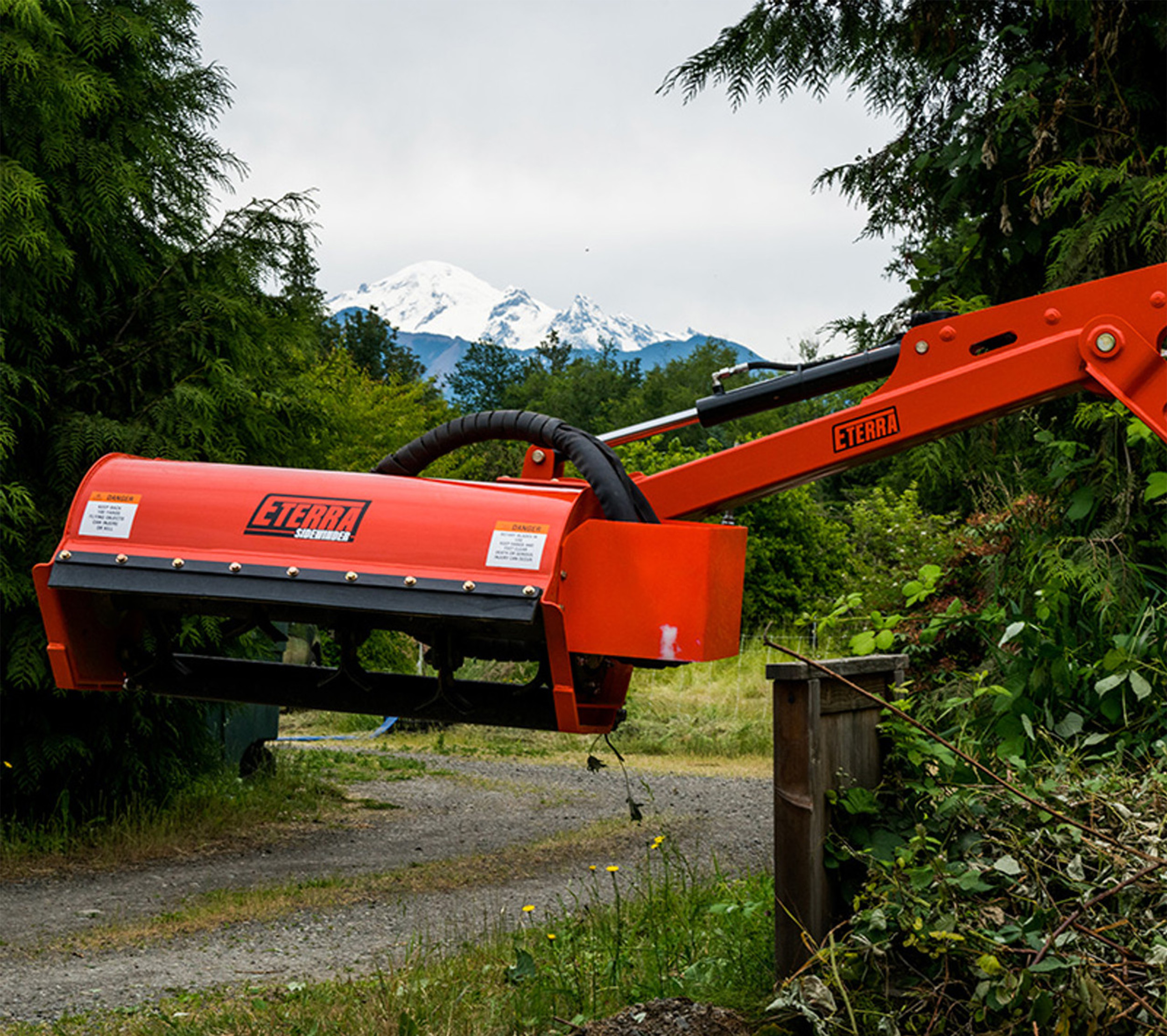
Clearing Mowers
Skid steer clearing mowers are designed for largescale land management. They level dense overgrowth, underbrush, and small to medium trees. Here's an overview of the design features that give clearing mowers the edge to perform these bigger jobs.
Cutting Mechanism
The center of the clearing mower is its rotor system, outfitted with specially designed blades. Driven by the skid steer's hydraulic system, the rotor spins at speeds of up to 29,000 feet per minute on some models, powering the blades shred, and sometimes mulch vegetation.
Drive System
Clearing mowers may use a direct-drive system for transmitting power to the rotor or a belt-drive system that can offer protection against shock loads by slipping under extreme resistance. High-performance hydraulic motors provide the torque needed for cutting through dense materials, and designs may include features to protect against hydraulic pressure spikes.
Safety and Debris Management
Given the potential for projectile debris, clearing mowers often feature heavy-duty front shields and rear chain curtains to contain material for operator safety. The rotor is designed not only for efficient cutting but also to minimize the projection of debris, focusing on mulching material down into the soil.
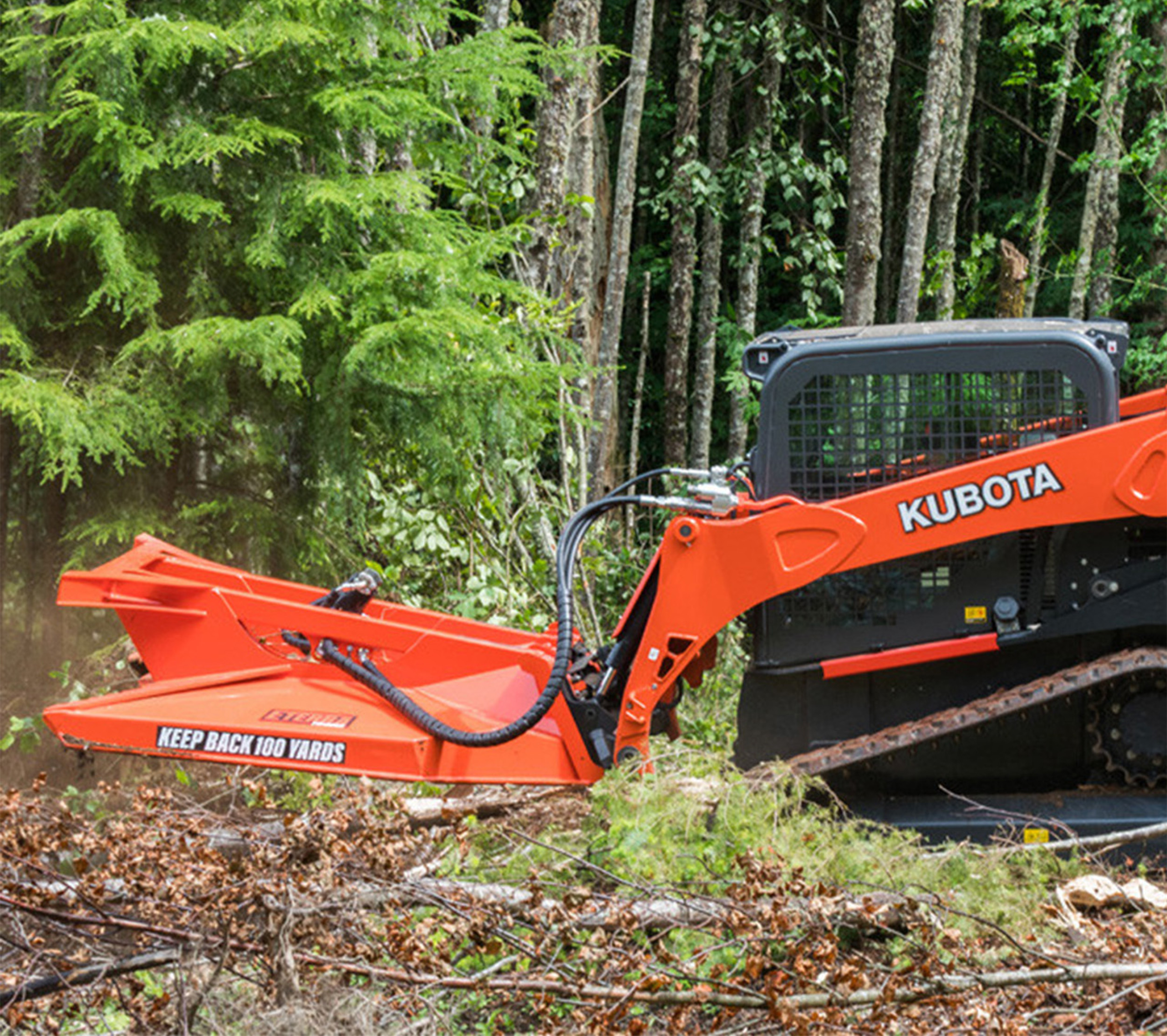
Sickle Bar Mowers
A skid steer sickle bar mower is a specialized attachment designed for precision cutting soft-stemmed plants. Its design allows for jobs that need a gentle touch, like trimming along ditches, around ponds, and under fences where other mowers might cause damage or cannot reach.
Sickle Bar and Teeth
The core of a sickle bar mower is a long, slender bar outfitted with a series of sharp, triangular teeth or blades. These teeth move back and forth in a scissor-like motion against a stationary guard, providing a clean cut.
Hydraulic Drive System
Sickles typically rely on a hydraulic motor to power the reciprocating motion of the blades. This setup allows for smooth operation and easy integration with the skid steer's existing hydraulic system.
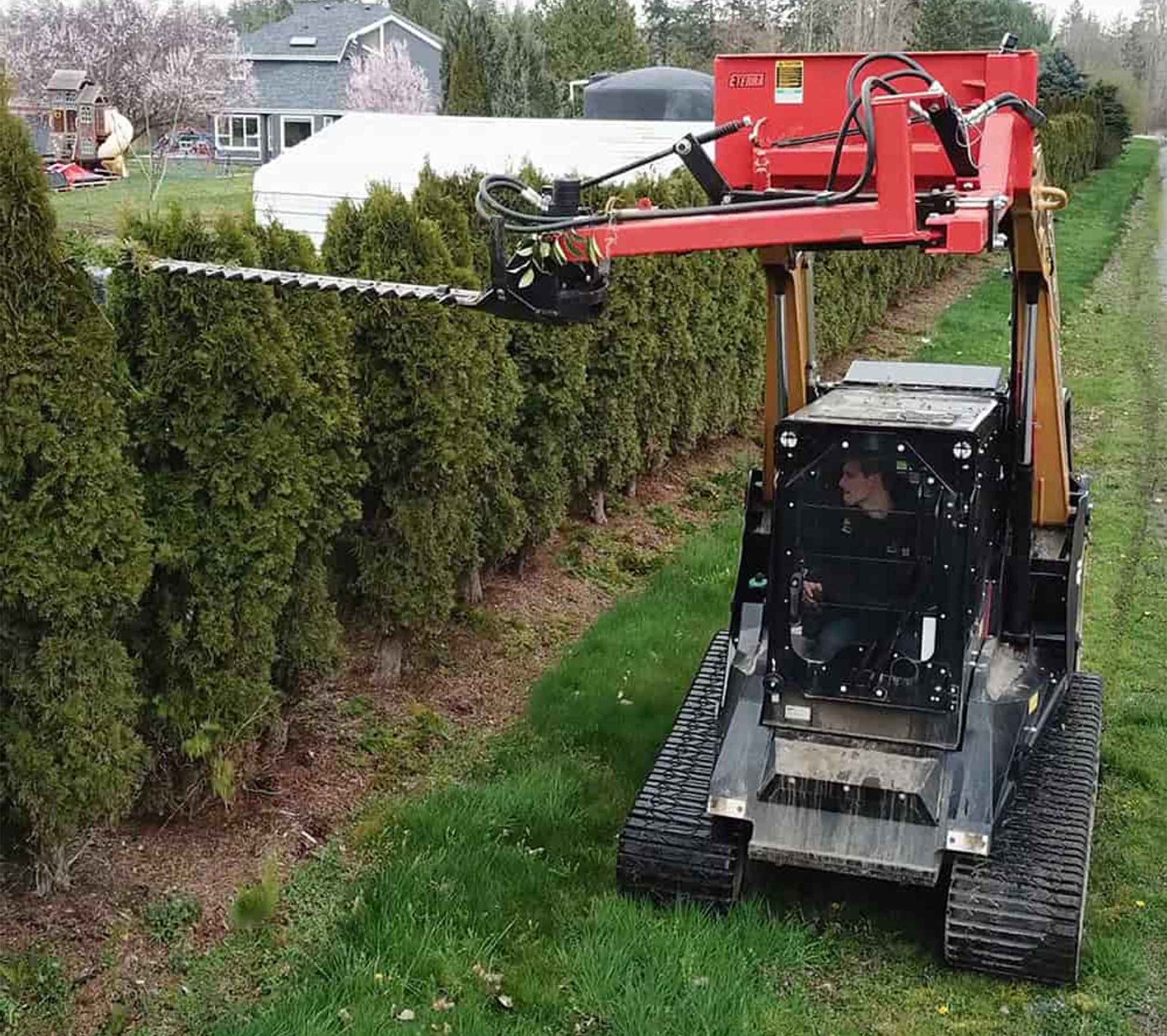
Boom Mowers
Skid steer boom mowers combine the versatility and mobility of a skid steer with the extended reach and cutting power of a boom, which is perfect for maintaining vegetation at funky angles like deep ditches. There are a few things you might need to know about these attachments and how they work.
Boom Arm
The boom arm is usually either a telescopic or articulated extension that gives the mower the reach and control you need. Often these attachments are made sturdy from high-strength steel to take the abusive of thick vegetation. The length of the boom can vary significantly, with some models offering extensions of a few feet.
Mower Head
The business end of a boom mower can be equipped with different types of cutting heads, including rotary cutters for grass and light brush, flail mowers for dense vegetation and debris, and even saw heads for cutting through tree limbs and thick brush.
Many mower heads are designed to rotate or articulate, allowing the operator to adjust the cutting angle to match the terrain or move around obstacles.
Hydraulic System
The boom mower utilizes the skid steer's hydraulic system to power the cutting head and to extend, retract, and articulate the boom arm. This integrated design lets the mower give you more precise control of the boom arm and mower head. This setup allows for adjustments on the fly to accommodate varying conditions and obstacles.
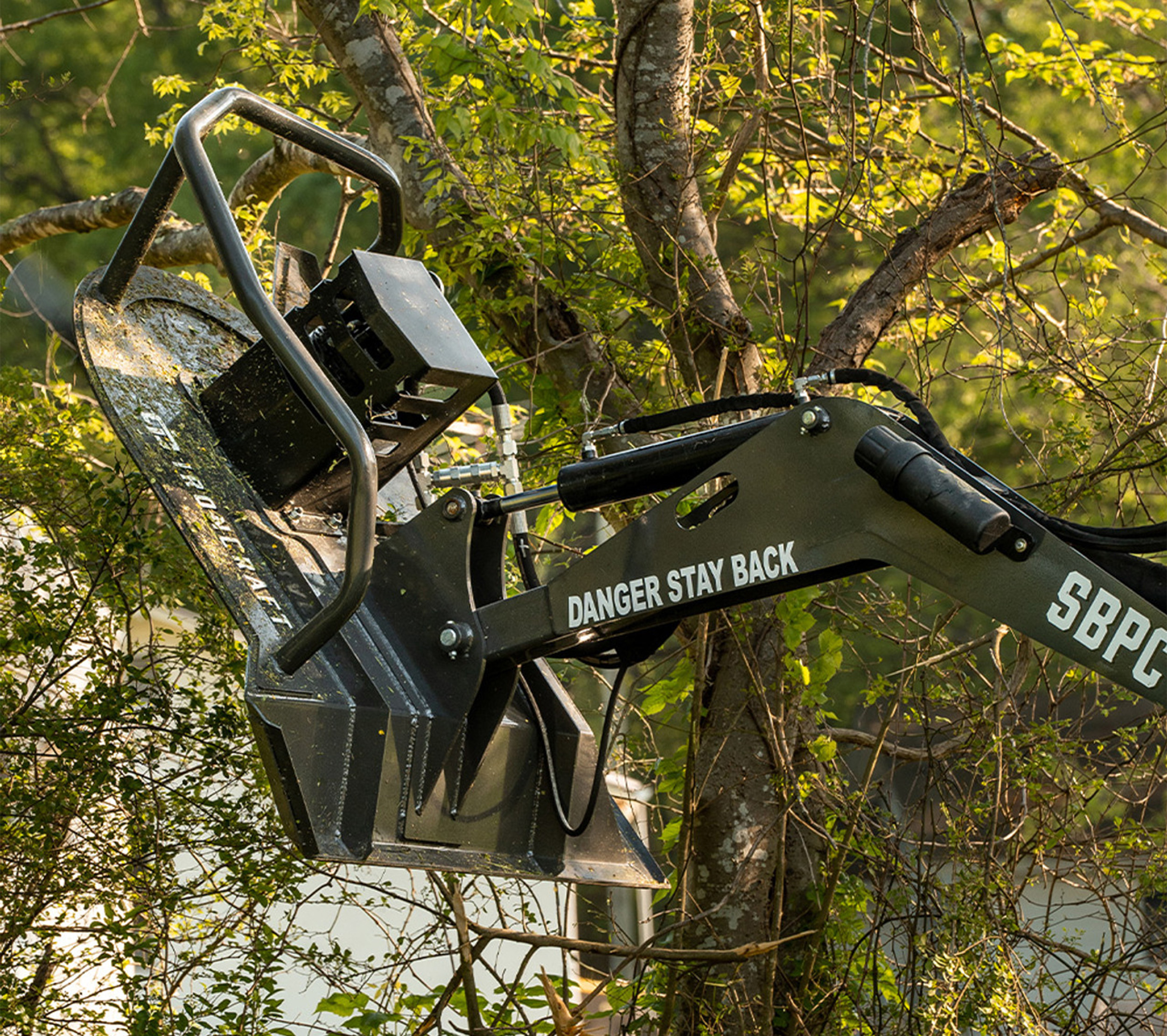
Simple Rules of Thumb
Rule 1: Cut Width
When you’re trying to decide the size of brush cutter, you will need to consider where you will be using it the most, how often you will use it and how much you plan to transport it.
Wider brush cutters cover more ground with each pass, which saves you time. If the area you're clearing is covered in obstacles, or narrow passages, you might look at a smaller brush cutter that will give you better control in tight spaces. Tough, woody plants may need more power to clear. In some cases, using a narrow-width brush cutter will put less strain on your hydraulic system over time, which keeps your equipment running better in the long run. So the average time you will spend running the cutter should be taken into consideration when you're looking at size.
Don’t forget about hauling it. If you'll be bringing the skid steer and brush cutter from jobsite-to-jobsite measure your trailer first to make sure they will both fit.
Rule 2: Safety and Maintenance
A couple of safety tips are, keep bystanders at least 200 feet away, never lift the blades above the cab door, check for obstacles before cutting, and ensure the cutter's blades have completely stopped before you jump out of the cab.
Keeping up on your regular maintenance, like greasing and checking for worn parts, will keep your mower reliable and performing well.
Rule 3: Double Check Flow Rate Compatibility
Always match the brush cutter's flow rate (gallons per minute, GPM) with your skid steer's hydraulic system. For example, if your skid steer has a flow of 20 GPM and the brush cutter requires 15-25 GPM, they are compatible.
If your skid steer's flow rate is lower than the minimum required by the brush cutter, the attachment may not have enough power to operate it. If the skid steer's flow rate is more than the maximum flow rate the attachment can handle, you could cause major damage to the hydraulic system of the brush cutter. Always pay attention and keep an eye on your flow.
Check the Hydraulic Pressure
While flow rate is crucial, it's also important to know the hydraulic pressure (measured in pounds per square inch, PSI) your skid steer generates compared to what the brush cutter requires. Mismatched pressure can affect performance and damage the attachment or skid steer. Usually, the manufacturer will specify the PSI needed alongside the flow rate requirements. For example: 15 – 20 GPM @ 3,000 PSI.
High-Flow vs. Standard-Flow Attachments
Determine whether the brush cutter is a high-flow or standard-flow model. High-flow attachments are designed for jobs that need more hydraulic power. If your skid steer doesn’t support high-flow attachments but the brush cutter requires it, you may have to pick a different model.
Consult Professionals
If you're unsure about matching your skid steer with a brush cutter attachment, you can always give us a call and our Sales Reps can give you some advice and help you avoid an expensive mistakes.
Mowing Tips
1. Prepare the Area
Before you start mowing, walk around a bit to find any rocks, big branches, or hidden debris that could damage the mower or become dangerous projectiles. Strategize your mowing path to maximize efficiency and minimize the need for unnecessary passes.
2. Adjust Settings for the Task
Adjust the mowing height based on what you’re cutting and your desired outcome. Lower for lawns or fine grass, higher for rough terrain and brush. Start at a lower speed until you get a feel for how the mower handles the terrain and vegetation. Adjust your speed to ensure a clean cut without overloading the skid steer's hydraulics.
3. Techniques for Efficiency
Slightly overlap each pass with the mower so you don’t leave uncut patches behind. Depending on the terrain and the shape of the area, mowing in straight lines or in a pattern can improve the overall look of the finished product.
4. Monitor and Adapt
Pay attention to the skid steer's hydraulic temperature. If the system begins to overheat, take a break to let it cool down. Be prepared to adjust your tactics based on vegetation density, terrain, and weather conditions.
5. Maintain Your Equipment
Before and after mowing, check the attachment for wear, damage, or clogging. Clean it as much as needed to keep it running smooth.
So, equipping your skid steer with the right brush cutter gives you an efficient, versatile attachment for land management across all levels and landscapes. The key to maximizing the performance and safety of your brush cutter is in choosing the right deck type, blade style, and model.
As you consider the various options available, remember that the effectiveness of a brush cutter is influenced by proper usage and maintenance. By understanding and implementing these tips and techniques, you can improve your overall efficiency and maintain the health and aesthetics of the landscapes you manage. Whether you're a professional in landscaping, agriculture, or construction, or simply a property owner looking to make your land management easier, investing in the right skid steer brush cutter can be a wise and fruitful decision.
Still have questions? Give our sales team a call: 866.966.2538





